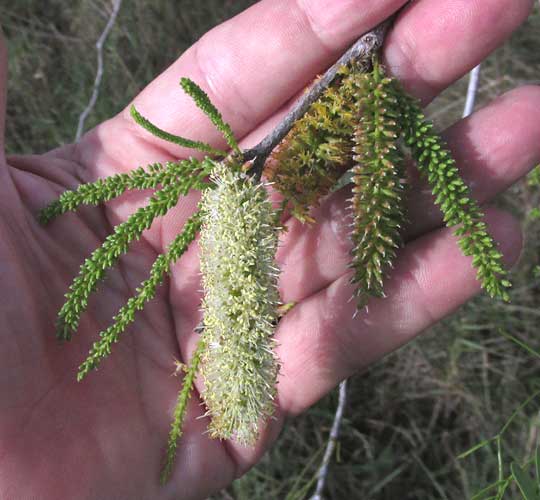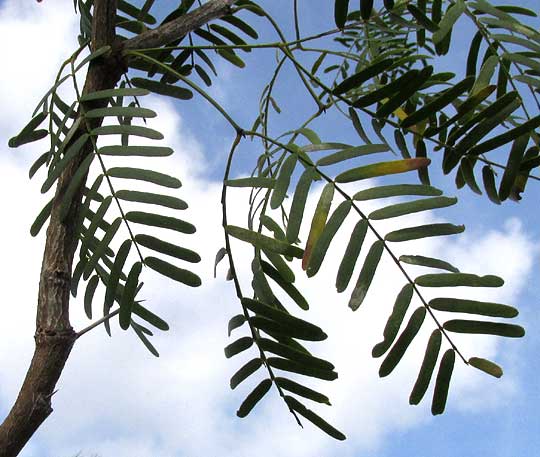Excerpts from Jim Conrad's
Naturalist Newsletter
from the February 1, 2015 Newsletter issued from Río Lagartos, on the Yucatan Peninsula's northern coast (~N21.60°, ~W88.16°), Yucatán state, MÉXICO
MESQUITE IN THE YUCATAN
We have mesquite trees here, and I've been eager for them to flower so I could figure out what's going on with them. For, unlike the mesquites that were so abundant back in southwestern Texas, sometimes these Yucatan ones turn up at the edges of marshes in what appears to be wet or at least moist soil. In Texas, mesquites grow on dry land. You can review the Texas mesquites, which were Prosopis glandulosa, at www.backyardnature.net/n/w/mesquite.htm.
This week a mesquite at the edge of a marsh just outside of Río Lagartos was flowering, and you can see its spikelike racemes below:

These flowering heads strike me as shorter and thicker than those back in Texas and northern Mexico. Below, you can see individual flowers, the cream-colored anthers atop their slender, white filaments tipped with the tiny, white, spherical glands for which the genus is famous:

The Y-shaped, twice-pinnately compound leaves were unmistakable mesquite leaves, though smaller than I recall the Texas ones being, as shown below:

So, this is a different mesquite species from the one we had in Texas. It's PROSOPIS JULIFLORA*, native to Mexico and the Caribbean area, plus there's debate about what other regions it's native too. One reason its origin is debatable is that it's been introduced into much of the rest of the world as an adaptable, sturdy tree capable of providing good shade, firewood and livestock fodder in hot, arid, treeless zones.
In fact, Prosopis juliflora has become a major invasive species in many of the planet's hot, arid regions. For example, with great expectations the tree was introduced into Ethiopia, but now "Over 700,000 hectares of prime grazing land and cultivable land following the Awash River is currently either invaded or at risk of invasion from prosopis in the Afar Region." The IUCN document saying this and detailing the situation is {no longer) freely downloadable in PDF format...
One reason Prosopis juliflora so aggressively invades treeless land is that invading treeless lands is its ecological job. In Nature, it's a "pioneer species" that stabilizes, shades and cools the soil, and holds moisture in the environment, enabling other less rugged species to take hold. In the Yucatan, mainly the tree occurs along the coast, with its numbers diminishing rapidly as one travels south and east, into areas with greater rainfall. The mystery is how this tree that shows affinities for arid land also occurs at the edges of our marshes.
Here in Mexico Prosopis juliflora is honored for the nectar it provides bees, and traditionally its resin has been used to treat dysentery and certain eye ailments. Also a tea from its cooked leaves has been used for inflamed eyes. A tea from its cooked flowers and root bark has served as a purgative, against intestinal worms, and for stomach aches.